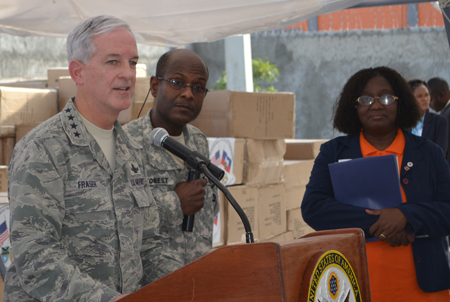Gen.  Douglas Fraser, head of US Southern Command, said Wednesday he spends about half of his time focused on transnational crime, most of which revolves around the drug trade. However, the command is only able to interdict about 33 percent of the drugs that it knows passes through its area of responsibility—which encompasses Central and South America—because it simply doesn’t have enough assets to stop more, Fraser told reporters in Washington, D.C. Part of the problem is that drug trafficking aircraft are landing in sovereign territory and Central American air forces don’t have the capacity to respond, he said. “The [Drug Enforcement Agency] is providing some capacity to respond, but we are just limited in our ability to cover such large territories and get to the right place at the right time,” he said. In fact, he said, the command’s interdiction rate is actually going down, meaning more drugs are getting through. Fraser said drug smugglers “are moving in to areas beyond the Western hemisphere.” He noted: “We are seeing increasing movement from Brazil to the northern parts of South America, down in to Argentina, into Western Africa, and Europe and the Middle East.” SOUTHCOM also is seeing an increase in “precursors,” such as methamphetamines, coming in from India and China, and then funneling through Mexico into the United States, he added. (See also SOUTHCOM’s Concerns from Air Force Magazine’s 2011 archive.)
Douglas Fraser, head of US Southern Command, said Wednesday he spends about half of his time focused on transnational crime, most of which revolves around the drug trade. However, the command is only able to interdict about 33 percent of the drugs that it knows passes through its area of responsibility—which encompasses Central and South America—because it simply doesn’t have enough assets to stop more, Fraser told reporters in Washington, D.C. Part of the problem is that drug trafficking aircraft are landing in sovereign territory and Central American air forces don’t have the capacity to respond, he said. “The [Drug Enforcement Agency] is providing some capacity to respond, but we are just limited in our ability to cover such large territories and get to the right place at the right time,” he said. In fact, he said, the command’s interdiction rate is actually going down, meaning more drugs are getting through. Fraser said drug smugglers “are moving in to areas beyond the Western hemisphere.” He noted: “We are seeing increasing movement from Brazil to the northern parts of South America, down in to Argentina, into Western Africa, and Europe and the Middle East.” SOUTHCOM also is seeing an increase in “precursors,” such as methamphetamines, coming in from India and China, and then funneling through Mexico into the United States, he added. (See also SOUTHCOM’s Concerns from Air Force Magazine’s 2011 archive.)
KC-46’s Refueling Boom Damaged While Refueling F-22s
July 8, 2025
A U.S. Air Force KC-46 tanker suffered damage to its boom while refueling F-22 Raptors off the coast of Virginia on July 8, Air & Space Forces Magazine has confirmed, with reported radio communication from the crew indicating the boom “detached.”